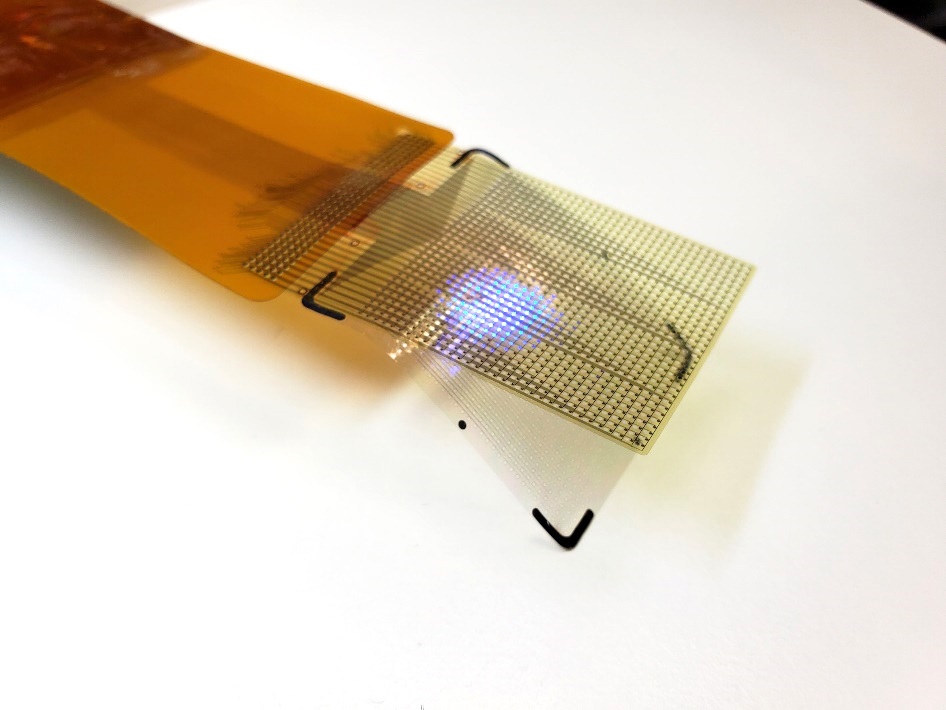Flexible Microdisplay Visualizes Brain Activity in Real-Time To Guide Neurosurgeons 
|
By HospiMedica International staff writers Posted on 26 Apr 2024 |

During brain surgery, neurosurgeons need to identify and preserve regions responsible for critical functions while removing harmful tissue. Traditionally, neurosurgeons rely on a team of electrophysiologists, positioned elsewhere in the operating room, to monitor brain function. Information about critical and non-critical brain areas is relayed to the surgeon either on paper or verbally, methods that can compromise the efficiency and accuracy of the surgery. Additionally, the electrodes typically used during these surgeries do not provide highly detailed data, creating the need for a resection margin of 5 to 7 millimeters to avoid damaging essential tissue, which may result in some harmful tissue being left behind.
Now, a collaborative research team that included engineers and physicians from the University of California San Diego (La Jolla, CA, USA) has developed a groundbreaking solution: a flexible microdisplay capable of both monitoring and visualizing brain activity in real-time during surgeries. This thin film integrates an electrode grid with LEDs to offer real-time, visual feedback of brain function, significantly enhancing surgical precision. This technology is designed to provide visual information about the brain to monitor the organ’s states during surgical procedures, helping neurosurgeons make informed decisions about which tissues to remove and which to preserve.
In proof-of-concept trials involving rodents and large non-primate mammals, the device successfully tracked and displayed neural activity, with LEDs lighting up red in areas designated for removal and green in regions critical for function. The technology also demonstrated its potential in mapping and visualizing the spread of epileptic seizures, identifying key areas involved in the condition. This capability could lead to targeted treatments, either by surgical removal of tissue or through electrical stimulation.
The research team is now advancing this technology by developing a microdisplay featuring 100,000 LEDs, aiming for a resolution comparable to that of a smartphone screen. This high-density LED array will represent the activity of hundreds of neurons per LED, providing unparalleled clarity and detail. The upcoming version of the microdisplay will also include a foldable section to facilitate surgical access while continuously displaying real-time brain activity, helping surgeons observe the immediate effects of their interventions. This innovation promises to make brain surgery safer and more effective, potentially transforming how neurosurgical procedures are conducted.
“Neurosurgeons could see and stop a seizure before it spreads, view what brain areas are involved in different cognitive processes, and visualize the functional extent of tumor spread. This work will provide a powerful tool for the difficult task of removing a tumor from the most sensitive brain areas,” said Daniel Cleary, one of the team members.
Related Links:
University of California San Diego
Latest Surgical Techniques News
- New Procedure Found Safe and Effective for Patients Undergoing Transcatheter Mitral Valve Replacement
- No-Touch Vein Harvesting Reduces Graft Failure Risk for Heart Bypass Patients
- DNA Origami Improves Imaging of Dense Pancreatic Tissue for Cancer Detection and Treatment
- Pioneering Sutureless Coronary Bypass Technology to Eliminate Open-Chest Procedures
- Intravascular Imaging for Guiding Stent Implantation Ensures Safer Stenting Procedures
- World's First AI Surgical Guidance Platform Allows Surgeons to Measure Success in Real-Time
- AI-Generated Synthetic Scarred Hearts Aid Atrial Fibrillation Treatment
- New Class of Bioadhesives to Connect Human Tissues to Long-Term Medical Implants
- New Transcatheter Valve Found Safe and Effective for Treating Aortic Regurgitation
- Minimally Invasive Valve Repair Reduces Hospitalizations in Severe Tricuspid Regurgitation Patients
- Tiny Robotic Tools Powered by Magnetic Fields to Enable Minimally Invasive Brain Surgery
- Magnetic Tweezers Make Robotic Surgery Safer and More Precise
- AI-Powered Surgical Planning Tool Improves Pre-Op Planning
- Novel Sensing System Restores Missing Sense of Touch in Minimally Invasive Surgery
- Headset-Based AR Navigation System Improves EVD Placement
- Higher Electrode Density Improves Epilepsy Surgery by Pinpointing Where Seizures Begin
Channels
Critical Care
view channel
AI Interpretability Tool for Photographed ECG Images Offers Pixel-Level Precision
The electrocardiogram (ECG) is a crucial diagnostic tool in modern medicine, used to detect heart conditions such as arrhythmias and structural abnormalities. Every year, millions of ECGs are performed... Read more
AI-ECG Tools Can Identify Heart Muscle Weakness in Women Before Pregnancy
Each year, some mothers die from heart-related issues after childbirth, with many of these deaths being preventable. Screening for heart weakness before pregnancy could be crucial in identifying women... Read morePatient Care
view channel
Portable Biosensor Platform to Reduce Hospital-Acquired Infections
Approximately 4 million patients in the European Union acquire healthcare-associated infections (HAIs) or nosocomial infections each year, with around 37,000 deaths directly resulting from these infections,... Read moreFirst-Of-Its-Kind Portable Germicidal Light Technology Disinfects High-Touch Clinical Surfaces in Seconds
Reducing healthcare-acquired infections (HAIs) remains a pressing issue within global healthcare systems. In the United States alone, 1.7 million patients contract HAIs annually, leading to approximately... Read more
Surgical Capacity Optimization Solution Helps Hospitals Boost OR Utilization
An innovative solution has the capability to transform surgical capacity utilization by targeting the root cause of surgical block time inefficiencies. Fujitsu Limited’s (Tokyo, Japan) Surgical Capacity... Read more
Game-Changing Innovation in Surgical Instrument Sterilization Significantly Improves OR Throughput
A groundbreaking innovation enables hospitals to significantly improve instrument processing time and throughput in operating rooms (ORs) and sterile processing departments. Turbett Surgical, Inc.... Read moreHealth IT
view channel
Printable Molecule-Selective Nanoparticles Enable Mass Production of Wearable Biosensors
The future of medicine is likely to focus on the personalization of healthcare—understanding exactly what an individual requires and delivering the appropriate combination of nutrients, metabolites, and... Read more
Smartwatches Could Detect Congestive Heart Failure
Diagnosing congestive heart failure (CHF) typically requires expensive and time-consuming imaging techniques like echocardiography, also known as cardiac ultrasound. Previously, detecting CHF by analyzing... Read moreBusiness
view channel
Expanded Collaboration to Transform OR Technology Through AI and Automation
The expansion of an existing collaboration between three leading companies aims to develop artificial intelligence (AI)-driven solutions for smart operating rooms with sophisticated monitoring and automation.... Read more

















